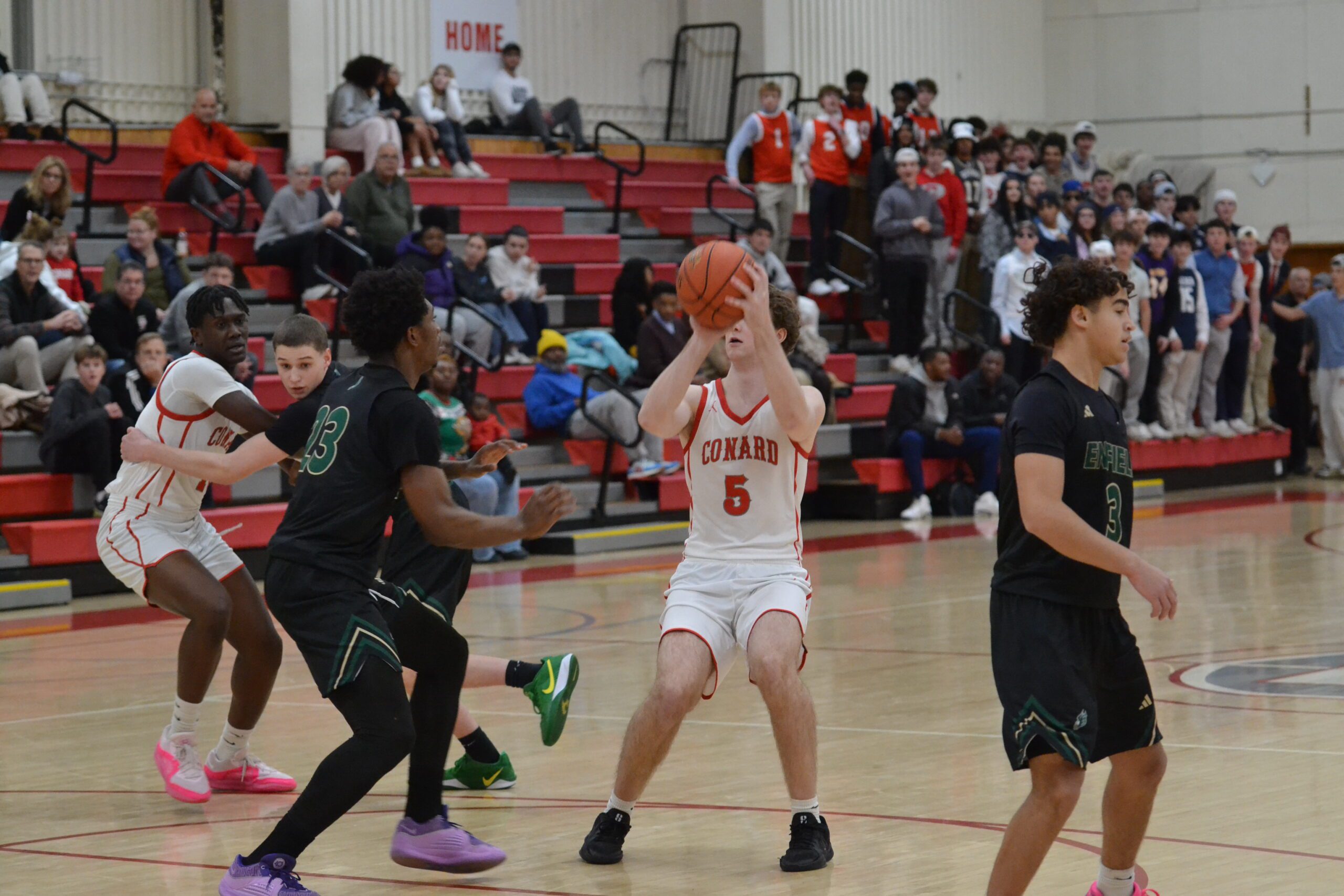From the West Hartford Archives: 1234 Farmington Avenue at Sunset Triangle

Audio By Carbonatix
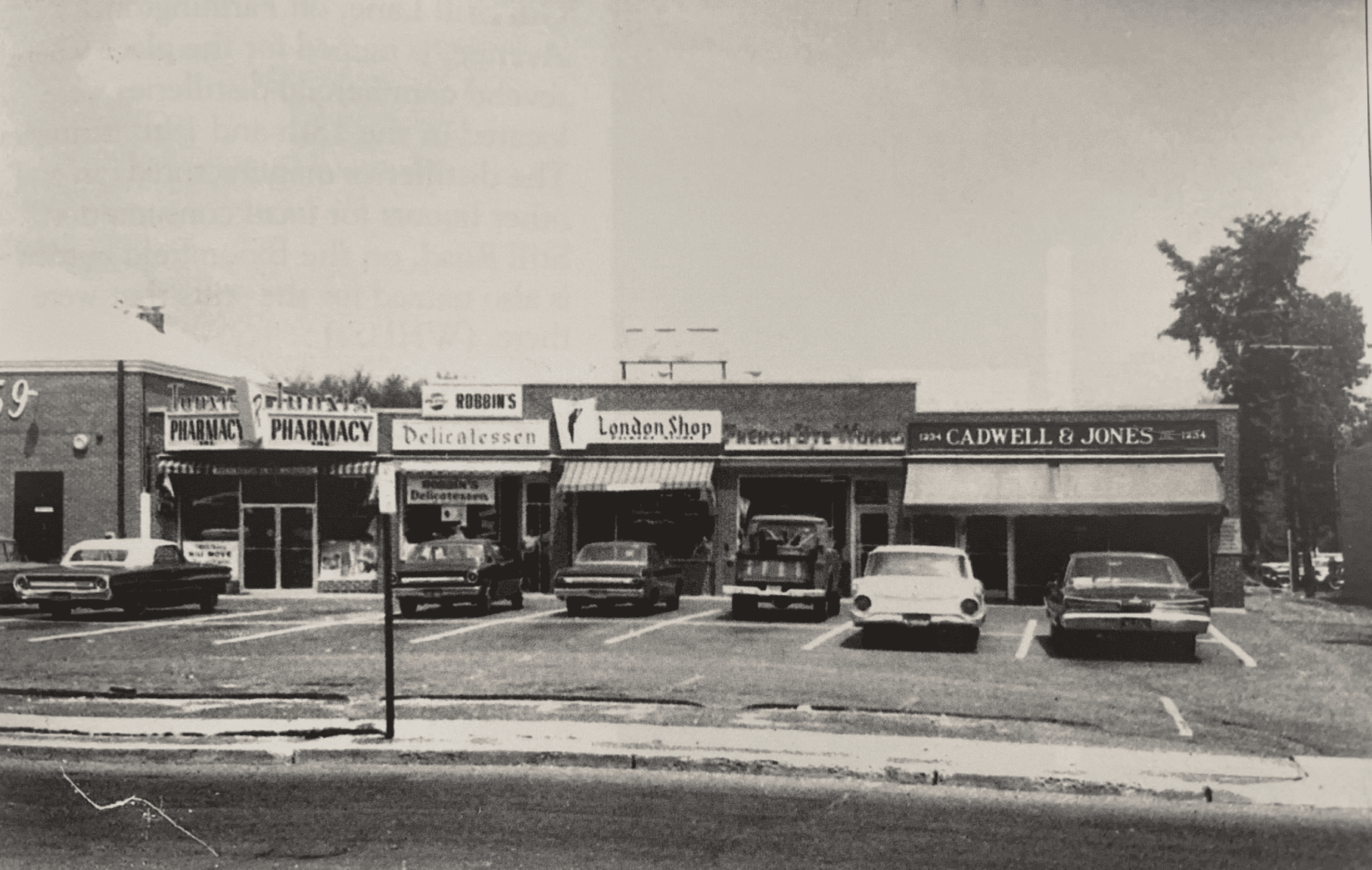
1234 Farmington Avenue. Courtesy of Noah Webster House & West Hartford Historical Society
Historian Jeff Murray takes a look into West Hartford’s past to uncover some surprising information, stir up some memories, or reflect on how much life has changed – or hasn’t changed at all. Enjoy this week’s ‘From West Hartford’s Archives’ …
By Jeff Murray
This business block was built at 1234 Farmington Avenue in 1951 on the north side of Sunset Triangle. The land was zoned for business in 1947 and sold to the Fazzano Brothers in 1950 for the construction of a new commercial building. They were the owners of an antiques store on Pearl Street in Hartford, but a new hotel was being proposed for the site and their store was going to be torn down. They needed new land to move their store to, making West Hartford an attractive option.
Construction started at the end of 1950, with parking in the front and a driveway leading to a service area in the rear. When the building opened on May 1, 1951, it was occupied by a number of stores that had a strong history in Hartford already.
Probably the most well-known was Cadwell & Jones, which sold seeds, farm supplies, and agricultural implements. It opened in 1895 on Main Street and their annual catalog boasted vegetable and flower seeds, and gardening equipment as well. By the late 1920s, they maintained a physical storefront and warehouse. After World War II, their business continued to adapt. Post-WWII America was fascinated with materials used in the war effort, like aluminum, which had been crucial in aircraft manufacturing.
They advertised their “Parkerette” lawn sweeper, made from high tensile strength cast aluminum alloy. Products marketed as lightweight, rust-proof, and high-tech appealed to a public eager for modern, lasting goods. Products that would have worked well on a farm in the days of rural land management transitioned to products that promised effortless yard maintenance, making post-WWII suburban living easier for middle-class homeowners.
By 1950, the need for a West Hartford branch (especially for a suburb like ours) was immense. It took over the far-right storefront and was one of two original stores from 1951 that remained into the mid-1960s.
The other was the French Dye Works. The main plant at 935 Farmington Avenue (which is still there) was formed in 1925 as a joint operation between the Mellman and Gassner families, who had founded the dry cleaning business in Hartford more than a decade before. By 1950, three more branches had been opened at 201 and 509 Farmington Avenue and in Unionville, but a fourth branch was needed. The commercial block at 1234 Farmington Avenue served as the right spot as it was finished in 1951.
Next door, D. J. Mahoney & Company sold a modern kitchen. Its first store opened in 1949 at 957 Farmington Avenue (in West Hartford Center), featuring sinks and countertops made from stainless steel and linoleum. It was owned by Dennis J. Mahoney, who spent four years in World War II with the Medical Corps. One of its ads in 1951 featured the simple question: “Have you seen America’s newest interior door?” Other ads highlight a housewife standing before an endless row of cabinets. Similar to Cadwell & Jones, the emerging importance of modern appliances and interior decorating in a suburban home pushed the company to move to 1234 Farmington Avenue in the new building, especially since it offered ample parking.
After it left this plaza in 1960, it gave way to the Colonial Delicatessen, which had a previous location at 496 Farmington Avenue in Hartford. In the summer of 1963, it was taken over by new management and renamed under proprietor Henry Wichmann to “Cracker Barrel Delicatessen.” By the time this photo was taken, it was Robbin’s Delicatessen, operated by Sidney Robbin. His father Harry, born in Russia, had founded Robbin’s Delicatessen on Main Street in Hartford for more than a half century. The West Hartford location was opened after Harry’s death in 1963.
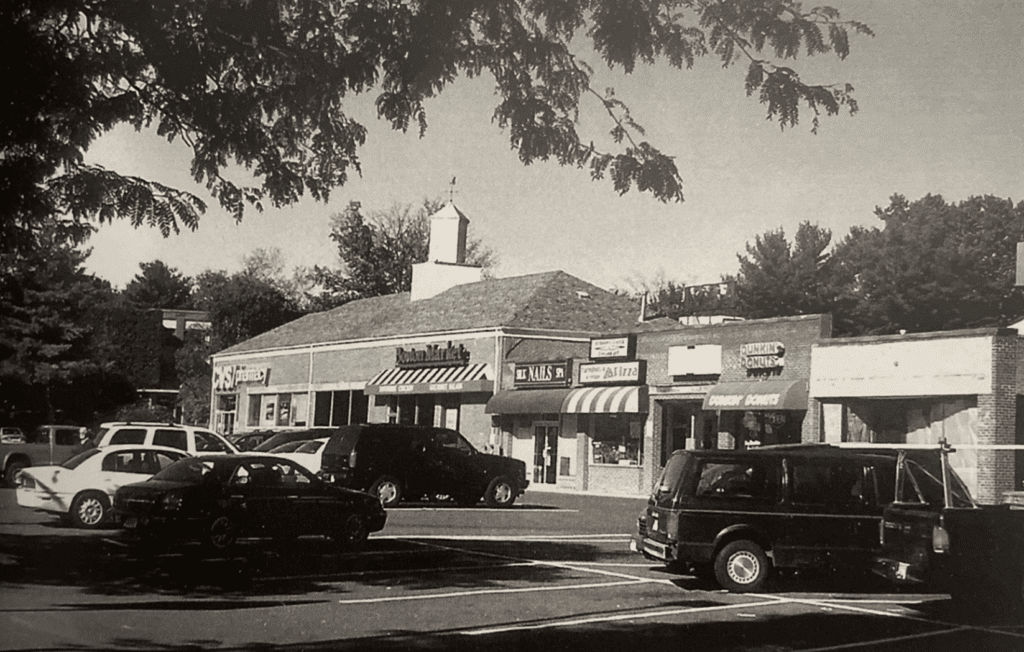
The same plaza (right half) in 2003. Photo courtesy of Noah Webster House & West Hartford Historical Society
The original store in the place of the London Shop liquor store was Grace Spencer’s Old Curiosity Shop. She had opened a shop with Elizabeth Hiscox at 986 Farmington Avenue in West Hartford Center in the fall of 1935, focusing on the sale of antiques, mainly old glass. A few years later, they opened a larger shop on Mulberry Street in Hartford as the Old Curiosity Shop. She made rounds every year at antique exhibitions across New England.
When the new business block in West Hartford was constructed, Spencer secured the lease for one of the original storefronts in the center. The shop closed in the early 1960s. In Dec. 1961, the London Shop package store applied for a liquor permit and opened in Grace Spencer’s former store in the spring of 1962. Its opening advertisement read: “Here ye, here ye. We wish to say the London shop is on its way. To lift you from the great big fog, our shelves are lined with grogs, not togs.”
This style of theatrical and absurd British humor tapped into a cultural phenomenon that was brewing in the U.S. in the early 1960s. The UK was becoming culturally “cool” again to American audiences, including comedies and the early roots of British music. The Beatles hit America in 1964, but the buzz was already starting. Themed liquor stores, boutiques, and bars used foreign or “exotic” branding to sound quirky and unique in a crowded market. The London Shop was no stranger to this style of marketing. A photo in the newspapers from 1964 shows a giant WINE SHED sign over several bottle-filled shelves. The store closed in the mid-1970s.
Finally, it’s time to circle back to the Fazzano Brothers, who started development on the building to begin with for their own store. After their Charter Oak Galleries antique store had to be vacated in Hartford for a proposed hotel, they were one of the original occupants in the new West Hartford building, taking the storefront at the far left. At the end of the 1950s, the store closed and the space was up for lease.
The Fazzano Brothers sold their entire stock of antique china, glass, furniture, silver, jewelry, pewter, and paintings at reduced prices. In its place, the Tunxis Pharmacy was opened in May 1959 by Frank Bonelli and George Loalbo. Both of them were friends and classmates at the University of Connecticut School of Pharmacy; they married sisters and lived in houses in West Hartford next door to each other. As a result, Tunxis Pharmacy became the neighborhood drugstore. The featured photo shows the Tunxis Pharmacy at its original location. In the fall of 1966, the store relocated to the building next door, where it remained for nearly 30 years.
Over that period of time, independent drugstores underwent a dramatic transformation from community-centered hub to struggling survivor in a corporate nightmare. After the mid-1960s, with the advent of Medicare and Medicaid, pharmacists at Tunxis had to deal with government payers, claims, and delayed reimbursement as third-party billing began to replace cash transactions. Employer-based health plans in the 1970s began adding prescription benefits, meaning that profit margins for Tunxis were healthy enough for the time being as long as insurers established good pricing.
However, by the 1980s, the rise of corporate chains like CVS and Walgreens began expanding aggressively across the U.S. These chains could negotiate better terms with the middlemen that set pricing for drugs, squeezing independent pharmacies with administrative burdens, payment delays, and shrinking dispensing fees. Bonelli’s daughter Carole had helped slowly computerize Tunxis Pharmacy through the late 1980s, but the changing insurance landscape loomed on the horizon.
Over 1,000 independent pharmacies nationwide closed their doors between 1980 and 1990. Chain pharmacies grew almost 20% from 1991 to 1992, while independents declined 12.5% in the same period. Health maintenance organizations limited which pharmacies patients could use. Chains had agreements with certain health insurance companies (like Cigna), forcing policyholders to fill their prescriptions only at that chain.
Finally, in 1993, CVS announced they were moving into the store next to Tunxis, which dug in its heels and declared war. They blamed hypocritical insurers for running independents into extinction. In 1994, Sedgwick Pharmacy closed and sold out to CVS. Tunxis faced the same fate the following year. At 6 pm on Dec. 31, 1995, they closed their doors and sold out to the neighboring CVS.
This one commercial block tells a lot of history in just a few stores. Today, the storefronts reflect the current business and cultural needs: a Dunkin Donuts, Korean and Chinese restaurants, and a nail salon. What story can historians tell about the 2020s in fifty years from our long list of local businesses?”
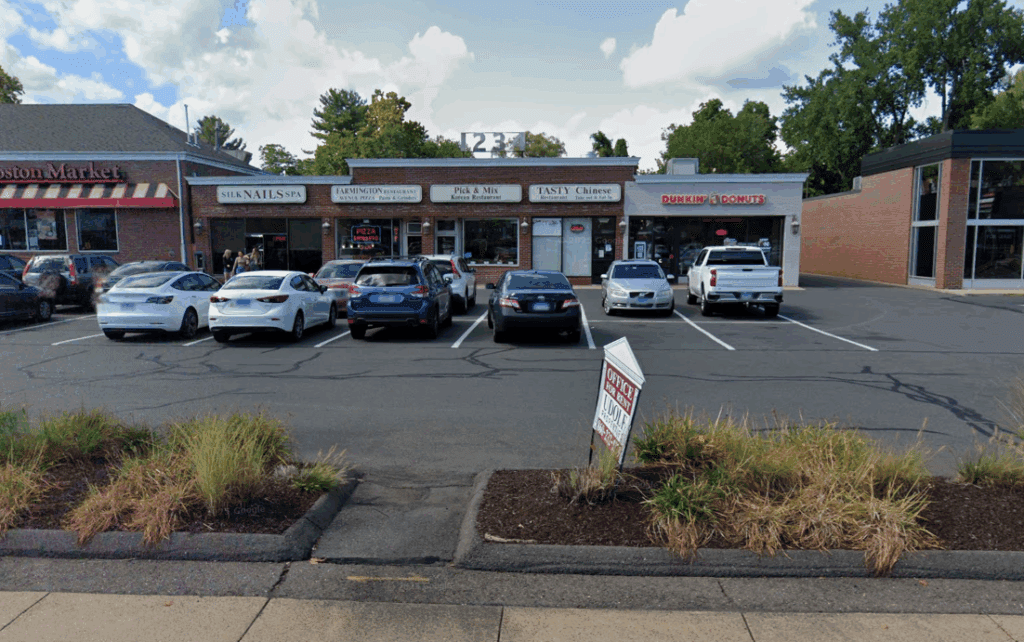
1234. Farmington Avenue. Google Street View, August 2022
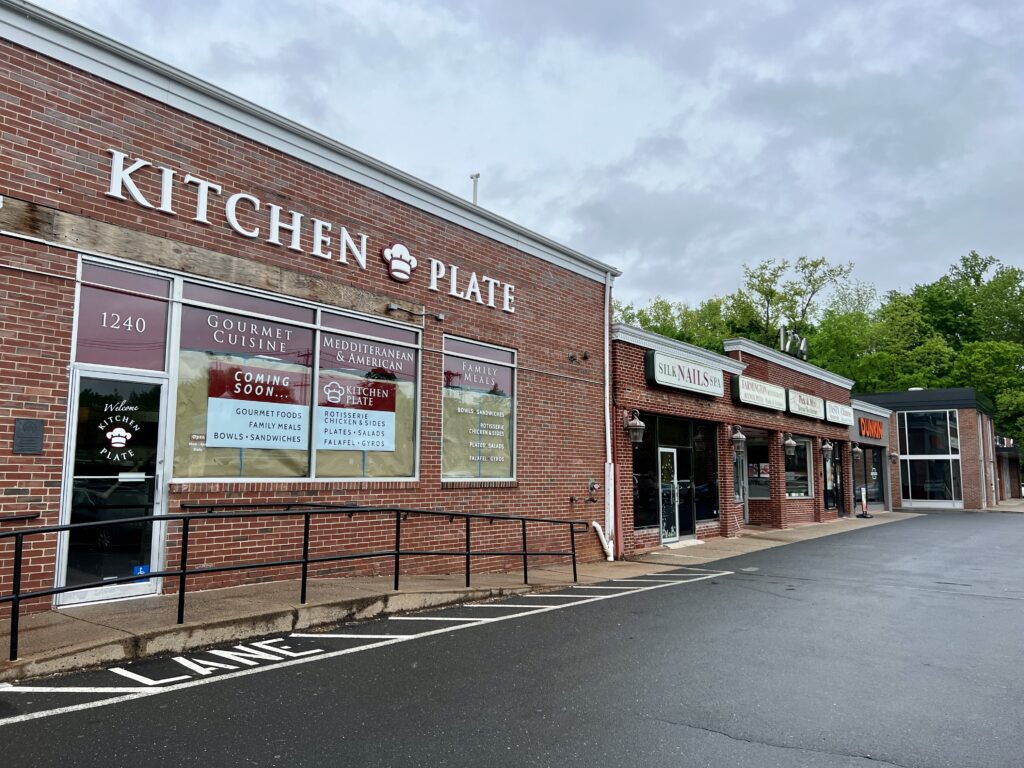
Kitchen Plate took the place of Boston Market in 2024. 1234 Farmington Avenue. Photo credit: Ronni Newton (we-ha.com file photo)
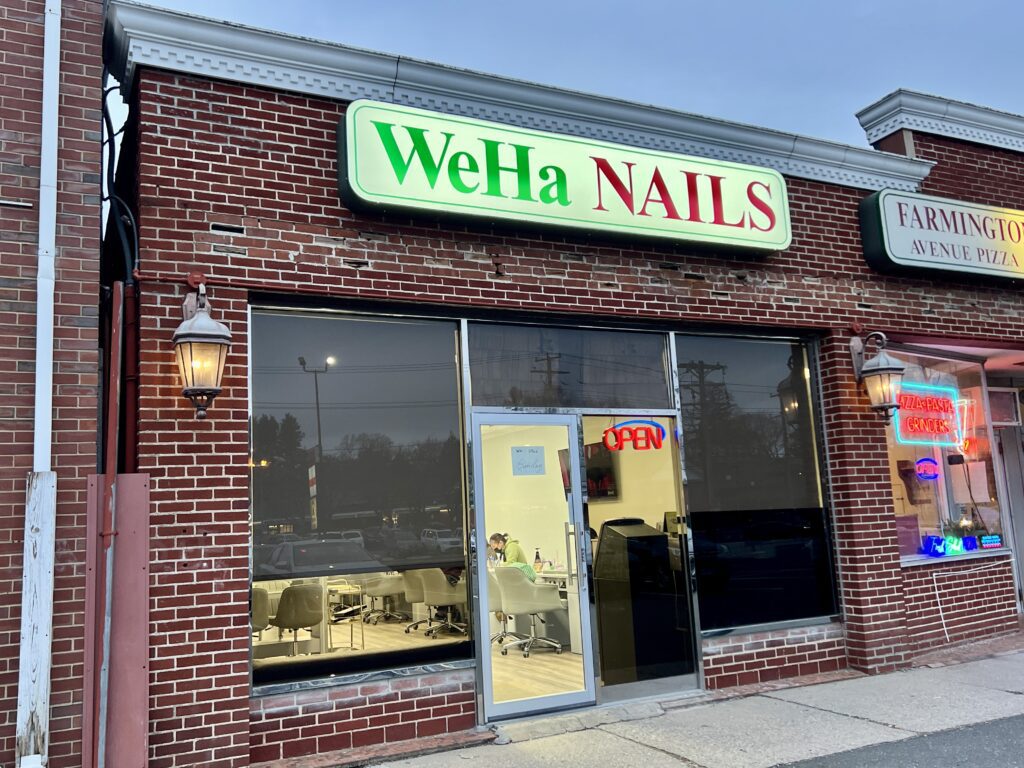
The former Silk Nails on Farmington Avenue in Sunset Triangle is now called WeHa Nails and is under new ownership as of early 2025. Photo credit: Ronni Newton (we-ha.com file photo)
Jeff Murray was born and raised in West Hartford and has been involved with the Noah Webster House & West Hartford Historical Society since 2011 when he was a high school student and won the Meyer Prize for his essay on local history. Jeff routinely volunteers as local history researcher uncovering information for numerous museum programs such as the West Hartford House Tour and West Hartford Hauntings. Jeff works as a data analyst at Pratt & Whitney.
Like what you see here? Click here to subscribe to We-Ha’s newsletter so you’ll always be in the know about what’s happening in West Hartford! Click the blue button below to become a supporter of We-Ha.com and our efforts to continue producing quality journalism.


